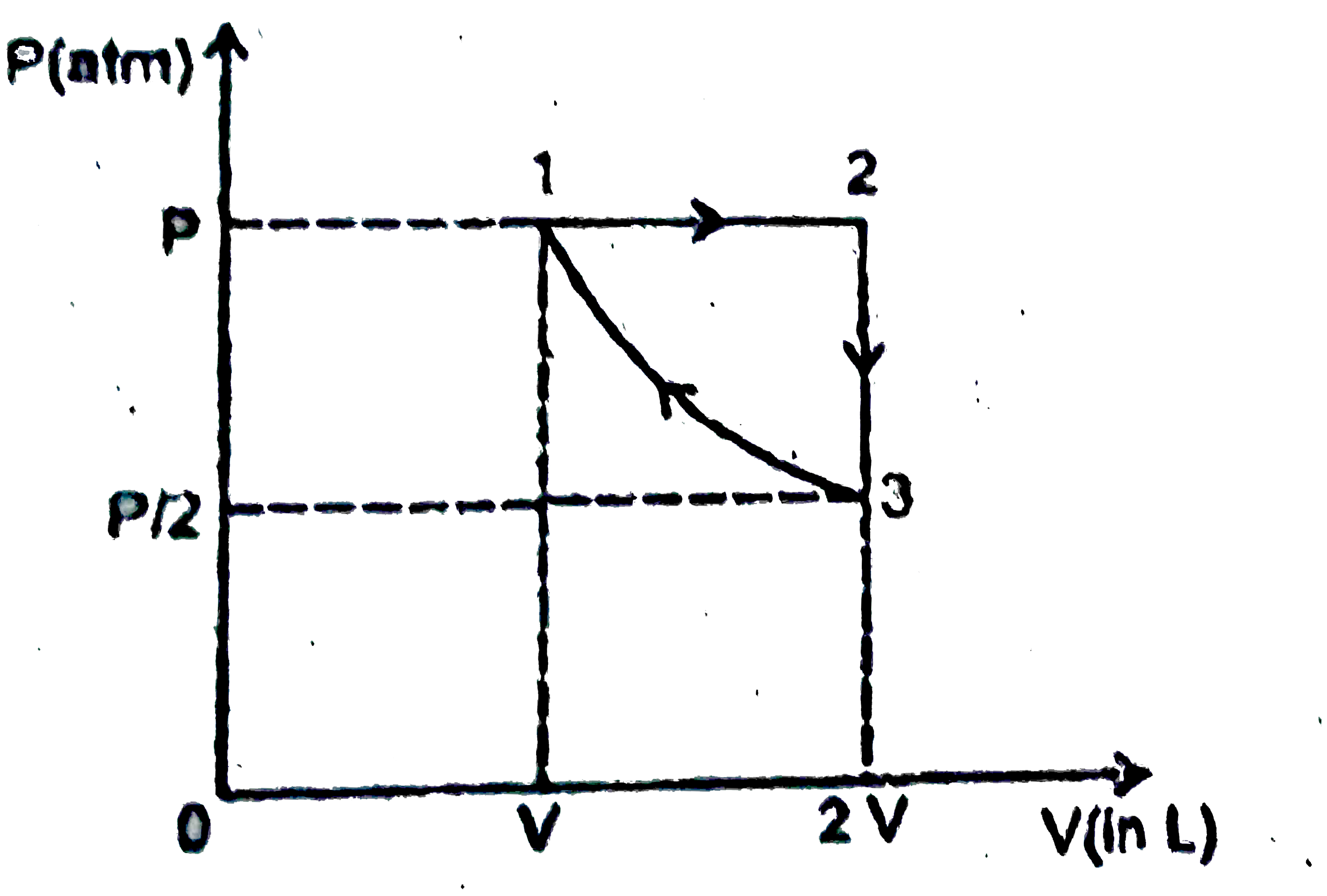Two moles of an ideal gas undergo the following process :
(a) a reversible isobaric expansion from (P atm, VL) to (P atm , 2VL).
(b) a reversible isochoric change of state from (P atm , 2V,L) to (P/2 atm, 2VL)
(c) a reversible isothermal compression from (P/2 atm, 2VL) to (P atm, VL).
Sketch with labels each of the processes on the same P−V diagram.




The correct Answer is:3
Step by step video, text & image solution for Two moles of an ideal gas undergo the following process : (a) a reversible isobaric expansion from ( P atm, V L) to ( P atm , 2V L). (b) a reversible isochoric change of state from ( P atm , 2V,L) to (P//2 atm, 2V L) (c ) a reversible isothermal compression from (P//2 atm, 2V L) to (P atm, V L). Sketch with labels each of the processes on the same P-V diagram. by Chemistry experts to help you in doubts & scoring excellent marks in Class 11 exams.
Updated on:21/07/2023Topper's Solved these Questions
Similar Questions
Two moles of a perfect gas undergo the following processes :
(a) a reversible isobaric expansion from (1.0 atm, 20.0 L) to (1.0 atm, 40.0 L)
(b) a reversible isochoric change of state from (1.0 atm, 40.0 L) to (0.5 atm, 40.0 L)
(c ) a reversible isothermal compression from (0.5 atm, 40.0 L) to (1.0 atm, 20.0 L)
(i) Sketch the labels of each of the processes on the same p-V diagram.
(ii) Calculate the total work (W) and the total heat change (q) involved in the above processes.
(iii) What will be the values of ΔU,ΔH and ΔS for the overall process ?
View SolutionTwo moles of a perfect gas undergo the following processes:
a. A reversible isobaric expansion from (1.0atm,20.0L) to (1.0atm,40.0L).
b. A reversible isochroic change of state from (1.0atm,40.0L) to (0.5atm,40.0L)
c. A reversible isothermal expansion from (0.5atm,40.0L)→(1.0atm,20.0L).
i. Sketch with lables each of the processes on the same P−V diagram.
ii. Calculate the total work (w) and the total heat change (q) involved in the above process.
iii. What will be the values of ΔH for the overall process?
View Solution
Knowledge Check
Maximum heat absorbed during isothermal expansion of an ideal gas from (10 atm, 1 L) to (1 atm, 10 L) is :
A90 atm-LB10 atm-LC9 atm-LD23.03 atm-L10 moles of an ideal gas are compressed isothermally and reversibly at 200°C from a pressure of 1 atm to a pressure of S atm. Then
AΔU=0,ΔH=0BΔU≠0,ΔH=0CΔU=0,ΔH≠0DΔU≠0,ΔH≠0
Two moles of a perfect gas undergo the following process: (a) A reversible isobaric expansion from (1.0 atm, 20.0 litre) to (1.0 atm,40.0litre). (b) A reversible isochoric change of state from (1.0 atm, 40.0 litre) to (1.0 atm, 40.0 litre). (b) A reversible isochoric change of state from (1.0 atm, 40.0 litre) to (0.5 atm, 40.0 litre). (c) A reversible isothermal compression from (0.5atm, 40.0 litre) to (1.0 atm, 20.0 litre). (i) Sketch with labels each of the process on the same P−V diagram. (ii) Calculate the total work (W) and the total heat change (q) involved in the above process. (iii) What will be the value of ΔU,ΔH and ΔS for the overall process?
View SolutionTwo moles of a perfect gas undergo the following processes:
a. A reversible isobaric expansion from (1.0atm,20.0L) to (1.0atm,40.0L).
b. A reversible isochroic change of state from (1.0atm,40.0L) to (0.5atm,40.0L)
c. A reversible isothermal expansion from (0.5atm,40.0L)→(1.0atm,20.0L).
i. Sketch with lables each of the processes on the same P−V diagram.
ii. Calculate the total work (w) and teh total heat change (q) involved in the above process.
iii. What will be the values of ΔG and ΔH for the overall process?
View SolutionTwo moles of a perfect gas undergo the following processes:
(a) a reversible isobaric expansion from (1.0 atm , 20.0 L) to (1.0 atm, 40.0 L)
(b) a reversible isochroic change of state from (1.0 atm , 40.0L) to (0.5 atm , 40.0 L)
(c) a reversible isothermal compression from (0.5 atm,40.0 L ) to (1.0atm, 20.0L)
Calculate the magnitude of work (W) done in L.atm
View SolutionTwo moles of a perfect gas undergo the following process: (a) A reversible isobaric expansion from (1.0 atm, 20.0 litre) to (1.0 atm,40.0litre). (b) A reversible isochoric change of state from (1.0 atm, 40.0 litre) to (1.0 atm, 40.0 litre). (b) A reversible isochoric change of state from (1.0 atm, 40.0 litre) to (0.5 atm, 40.0 litre). (c) A reversible isothermal compression from (0.5atm, 40.0 litre) to (1.0 atm, 20.0 litre). (i) Sketch with labels each of the process on the same P−V diagram. (ii) Calculate the total work (W) and the total heat change (q) involved in the above process. (iii) What will be the value of ΔU,ΔH and ΔS for the overall process?
View SolutionWrite expression for the work done by 1 mole of the gas in each of the following cases :
(i) For irreversible expansion of the gas from volume V1 to V2.
(ii) For reversible isothermal expansion of the gas from volume V1 toV2.
(iii)For expansion of the gas into an evaluated vessel.
(iv) For reversible isothermal compression of the gas from pressure P1 to P2
(v)For adiabatic expansion resulting into change of temperature from T1 to T2.
View SolutionCalculate entropy change (in joule) for reversible isothermal expansion from 5L to 15L for 2 mol of an ideal gas.
View Solution

